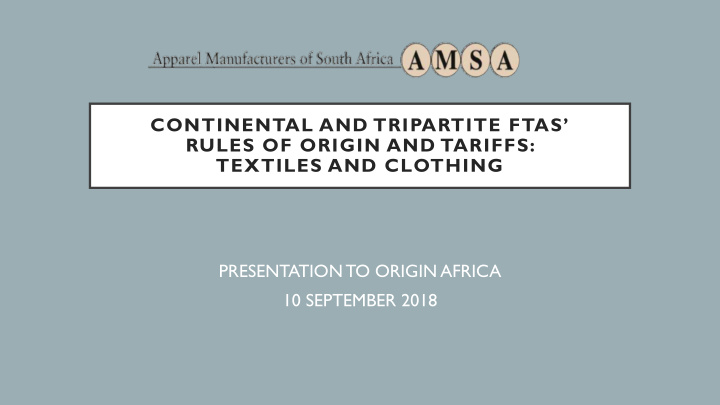



CONTINENTAL AND TRIPARTITE FTAS’ RULES OF ORIGIN AND TARIFFS: TEXTILES AND CLOTHING PRESENTATION TO ORIGIN AFRICA 10 SEPTEMBER 2018
INTRODUCTION • AU Commodity Strategy Based on Value Addition for Global Competitiveness Utilise Natural Resources to promote industrialisation through value addition strategies • Cotton – Textiles – Apparel Value Chain needs extensive development
AFRICA’S TOP COTTON PRODUCERS 2018/19 (USDA) Country Production (‘000 tons) World 26 242 Africa 1 641 West Africa 1 196 Egypt 91 Tanzania 87 Zimbabwe 50 Zambia 44 South Africa 39 Ethiopia 38 Uganda 27 Mozambique 24 Malawi 20 Madagascar 7 Kenya 5
AFRICA’S TOP EXPORTERS OF TEXTILES AND CLOTHING (IDC) Country Clothing T extiles 2017 Export Value 2017 Export Value (US$bn) (US$bn) World 524,2 328,9 Africa 11,4 4,9 Morocco 3,5 0,5 Tunisia 3,3 0,3 Egypt 1,6 1,4 Mauritius 0,7 SA 0,6 0,9 Madagascar 0,5 Benin - 0,4 Burkina Faso - 0,2 Other 1,3 1,2
TRADE AGREEMENTS • Variety of Trade Agreements around the World • Different Rules of Origin apply • T extiles and Clothing usually have sector specific rules – Chapter rules • Common and Differentiated Tariff Structures • Tariffs and Rules of Origin form a package
COMPETITIVENESS • Fundamental to any strategy • Different ways of achieving it • Value added Niche markets • Quick turnaround short runs ignores stockholding demands by retailers • Large volume production also plays a significant role locally and internationally • Longer runs also critical for developing export capability
AFCFTA • Rules of Origin –T extiles and Clothing • Single stage or T wo stage conversion • AU Value Added Strategy – Cotton Value Chain • Single stage – Only Labour resource utilised Short-term Opportunistic • T wo stage –Value addition through Value Chain Long term vision – Greater Economic Development
AFCFTA • Rules of Origin –T extiles and Clothing • Alternative rule: % imported materials • High Import % = Low Value Added • Rule of thumb –VA< 50%, not profitable/ non-viable • AU Value Added Strategy • Value addition through Value Chain Long term vision – Greater Economic Development
AFCFTA • Rules of Origin –T extiles and Clothing cont. • Cotton vs Synthetics Dilemma • World Synthetic fibre production > Cotton • Africa produces cotton but no synthetic fibre • Some synthetic yarn spinning capacity • Relaxed RoO for synthetics undermines Cotton potential
AFCFTA • Tariffs Differentiated tariff structure Distortions on inputs Complicates Equitable Trade EU Common Market: Uniform tariff, Common Currency
AFCFTA Conclusion • Rules of Origin and Tariff Preferences form a package • Principle of Free Trade vs Value Addition Strategy • Value Addition requires 2-stage conversion • Alternate view: 1-stage yields growth for future backward integration • Alternate view: % Imported materials requires 50% Value Added • Differentiated external tariffs distort competitive environment
THANK YOU Paul Theron paul.theron@amsa.za.org
Recommend
More recommend